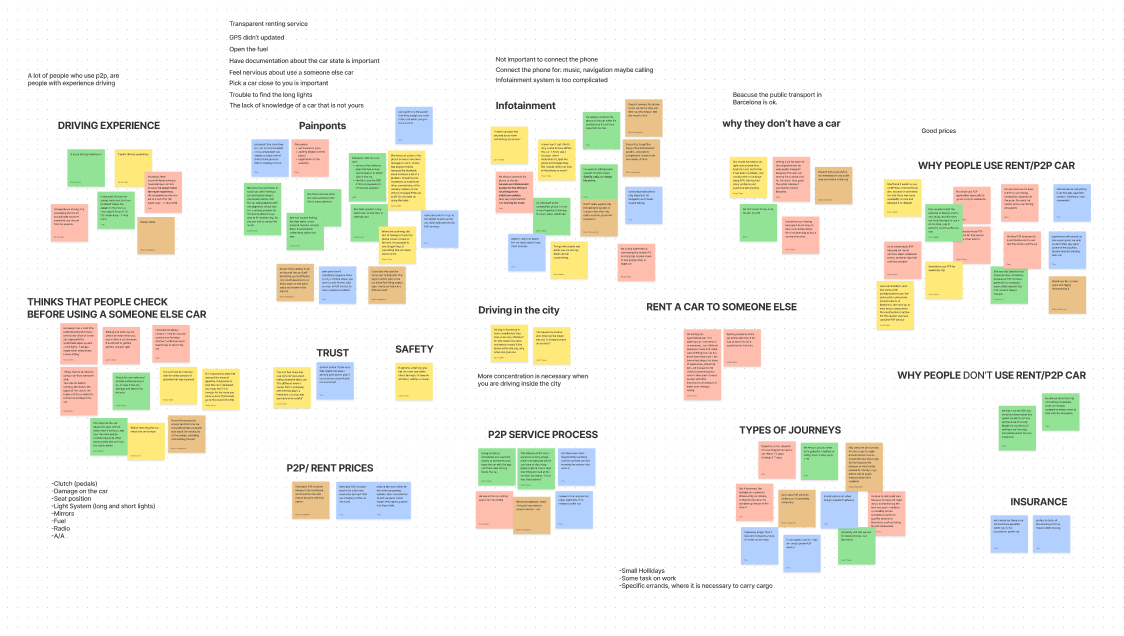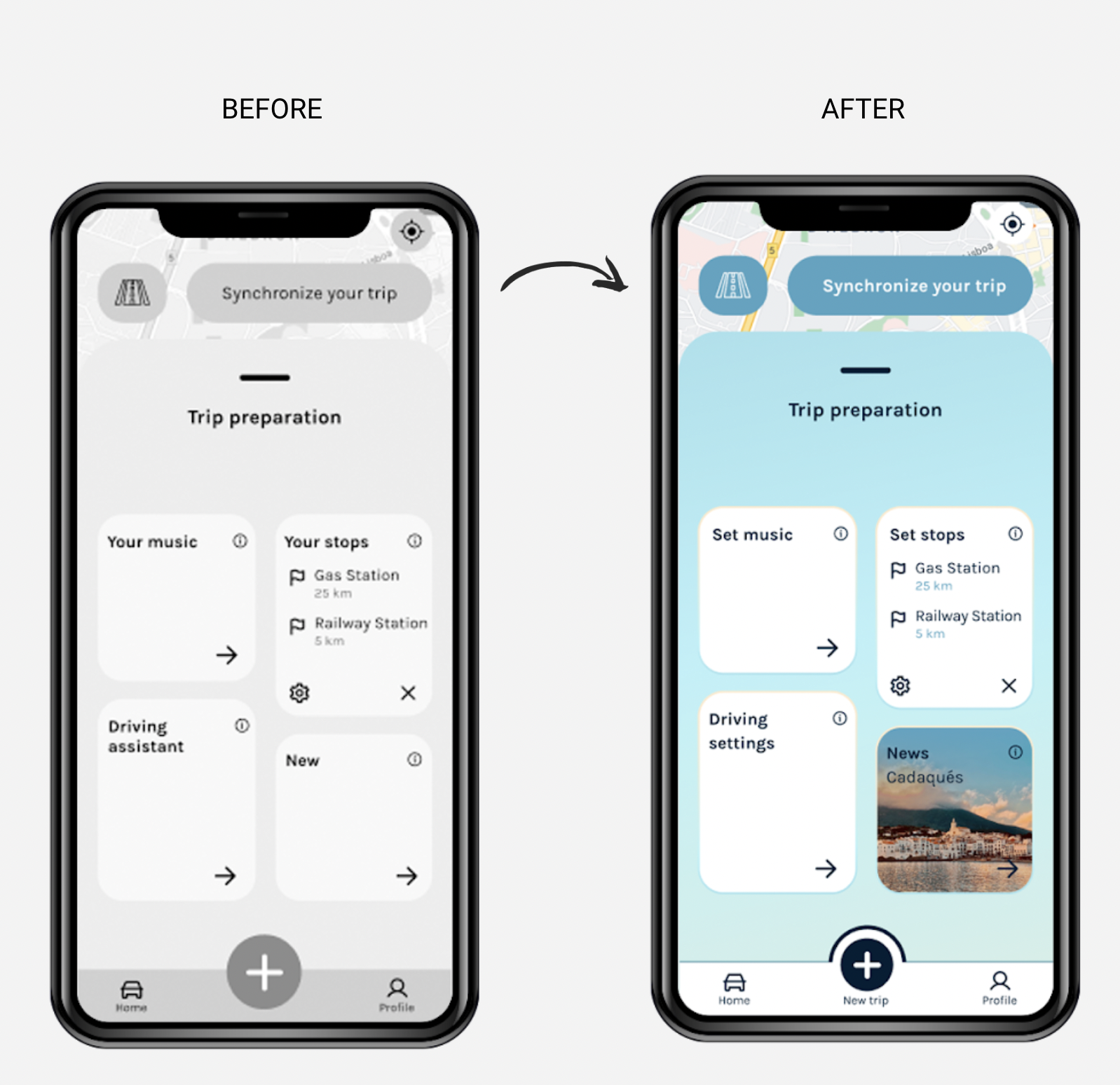Personalization of the digital driving experience
Toyota Connected Europe meets AllWomen
UX challenge
─ Project Overview ─
Description:
The freshly graduated UX/UI students from AllWomen received an opportunity from Toyota Connected Europe to take part in a UX challenge regarding the personalization of the driving experience. We worked in small teams where everybody took part in every UX design stage.
We targeted the Barcelonian drivers and through our research, we realized there is currently a significant increase in the tendency toward car sharing in Europe. For this reason, we focused on how we might personalize the digital driving experience in peer-to-peer car-sharing in Toyota cars and involve the infotainment system and a smartphone application.
Duration: 3 months│Project type: UX challenge
My role: Research│UX design│Visual design│Prototyping
Used programs: Figma│FigJam│Google Sheet
─ First research ─
In our first research, we wanted to build a strong basic knowledge about drivers’ feelings, get more objective knowledge about infotainment systems, and examine the data about driving in Barcelona.
We interviewed 6 car owners from Barcelona about their driving habits and what their experiences are with driving in the city.
"The app for my car is really useful. You can know if the windows are closed or where is the car, but actually, I never used the app”
- Carolina, Mini owner
“I like to listen to podcasts when I am on the road to work (out of Barcelona)“
Joan, Toyota owner
“I use the car only if is necessary I prefer to go by bicycle"
- Carolina, Mini owner
“I use the car just because I like small trips on weekends“
- Laura, Toyota owner
“It‘s really hard parking in Barcelona, for that reason I don't like driving in the city"
- Felix, Mini owner
We studied “What are the problems with the infotainment systems?“ and which cars have the best technology. Furthermore, what is the attitude toward car ownership in the city.
Source: https://www.thedrive.com/tech/34350/the-infotainment-systems-are-still-bad
“Millennials are losing interest in driving“
Source: www.xataka.com
Barcelona Government promoting the progressive abandonment of private car transportation and promoting car sharing if using the car is needed.
https://www.barcelona.cat/mobilitat/en/means-of-transport/car
─ Outcomes from the first research ─
Car usage in Barcelona is being discouraged due to the commitment of the city to being greener
Reduced ownership of cars by younger drivers due to different limitations
Growing usage of car sharing services when the use of the car is necessary
Assumptions:
People often don’t understand the functions or limitations of a car’s digital system.
Privacy is a concern for drivers that share their cars / use other people’s cars.
People who don’t drive a lot are hesitant to use a P2P service because they are uncomfortable driving an unfamiliar car.
First hypothesis:
We believe that [creating a way to greatly personalize the digital touchpoints of the cars] for [young drivers in Barcelona that use car sharing services] will achieve [higher confidence in their driving experience].
─ Second research ─
Based on our first research, we investigated the car-sharing system and how people think and feel about it.
We interviewed 7 people (who live in Barcelona and don’t have a car but from time to time they rent one) about What they think of the car-sharing system?
Our findings:
Relying on the phone instead of the car system makes users feel unsafe while driving
Not knowing the new car makes users feel unsafe while driving
Initial physical setup in cars is not always straightforward
Forgetting to check something before starting to drive can end in unsafe situations while driving (looking for the lights etc.)
Lending a car to/from somebody requires a leap of faith which puts pressure on the driver
Infotainment systems are so complicated at first sight that drivers don’t use them
Connecting the phone is complicated
Privacy issues when connecting the phone to the car
“I prefer to not touch anything, I might mess something up without knowing how to fix it and end up in an unsafe situation while driving“
We decided to focus on two main user problems and test them. Additionally, we refined our hypothesis.
Problem 1
Understanding a new car through the infotainment system
Problem 2
Using the phone is more convenient
Pictures from Freepik
Refined hypothesis:
We believe that [providing guidance on the digital touchpoints of the car] for [young drivers in Barcelona that use car sharing services] will achieve [higher confidence in their driving experience].
─ Ideation and User flow ─
Based on our information we made some ‘Crazy 8’ brainstormings. We had decided that we would test a scenario where the user already registered for the P2P car sharing application and would try to set his/her first route by adding extra stops.
We determined that the user flow would contain the following steps:
Considering the time frame we narrowed down our search scope to just the ‘before driving’ part.
─ First testing ─
We tested our first prototype on 4 users. We get very helpful feedbacks about which part is confusing or unnecessary. Furthermore, we realized that we have to add an extra step to the user flow about “finishing the driving”.
“Before using the car” user flow
Result and findings:
“In the car before the car” user flow
─ Second testing, findings, and changes ─
Trip Preparation and Search
The button to add a new trip was not visibly, users go directly to the search bar
Users search for an address in the search bar instead of recent trips
System remembering your last trips was really appreciated
Adding stops in the infotainment system
The trip preparation ideas in the app are perceived as promotion/marketing
Rating my trip
It was unclear what exactly is being rated, maybe a feedback section would be good
Adding stops in the infotainment system
The flow of adding a coffee break stop is not clear
That the system knows my habits is nice, but also uncomfortable
Car tour flow
Flow of the tour was confusing for the user.
─ Mood board and branding ─
─ Next steps and learnings ─
We were still left with some unanswered questions which will require further investigation and validation.
Personally, what I learned from this project is that sometimes it’s more complicated to define the problem, and making a proper action plan is essential. I realized the importance of the right UX copywriting and that I have to be more punctual in the future.
Thank you for reading!
If you want to get more information about the project, don’t hesitate to contact me!






















